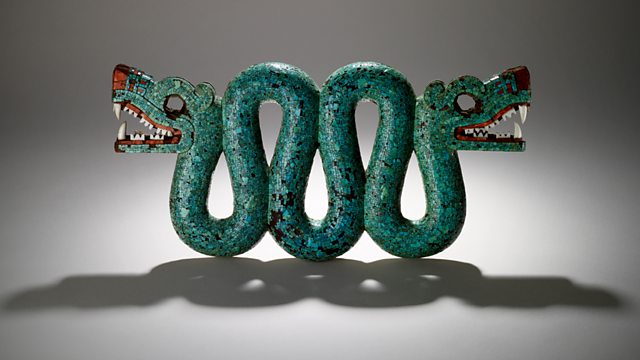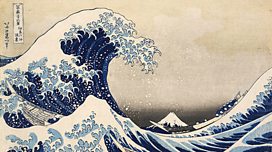Double-headed serpent
Neil MacGregor is this week focusing on European encounters around the world between 1450 and 1600. Today he is one of the great objects of the Aztecs - a turquoise serpent.
The history of humanity - as told through one hundred objects from the British Museum in London - is back in South America. This week Neil MacGregor, the museum's director, is with objects from around the world between 1450 and 1600. This is the time of huge European expansion thanks to the new developments in ship building. Today he is with an object made by the Aztecs of present day Mexico. He describes the Aztec world and the Spanish conquest of this culture, through a double-headed serpent made from tiny pieces of turquoise - one of the stars of the British Museum. The Aztec specialist Adriane Diaz Enciso discusses the role of the snake in Aztec belief while the conservator Rebecca Stacey describes the scientific detective work that the object has prompted.
Producer: Anthony Denselow
Last on
![]()
Discover more programmes from A History of the World in 100 Objects about art.
About this object
Location: Mexico
Culture: Aztec, Maya and Central America
Period: AD 1400 -1600
Material: Shell, Wood and Gemstones
听
This serpent mosaic was created in Aztec Mexico. It may have been worn or carried during religious ceremonies. Snakes were sacred to the Aztecs as they were the symbol of the feathered serpent god, Quetzalcoatl. The Aztec Empire consisted of many subject territories, stretching from the Gulf of Mexico to the Pacific. Frequently they had to provide gifts as tribute to demonstrate their allegiance to the Aztec emperor. Tributes in the form of turquoise were particularly highly valued.
How was the Aztec Empire destroyed?
The arrival of the adventurer Hernando Cortez and his Spanish troops around 1519 brought an end to the Aztec Empire. The Spanish expedition was met by the Aztec emperor, Moctezuma who exchanged gifts, including possibly this turquoise serpent, with Cortez. In a surprise move Cortez imprisoned Moctezuma. After bitter fighting and a prolonged siege the Aztec capital, Tenochtitlan, fell to the Spanish in 1521. Much of the native population was wiped out by epidemics of smallpox and other contagious diseases brought by the Spanish.
Did you know?
- When this was made, the Aztec capital Tenochtitlan was one of the biggest cities in the world.
Making a statement
By Frances Berdan, California State University San Bernardino
听
This extraordinary object made an important statement in Aztec life. Several statements actually.
First of all, Aztec people lived in a society that was socially divided and very status-conscious. There were powerful kings, haughty nobles, wealthy merchants, aspiring warriors, poor farmers, and humble slaves. A king was distinguished by his blue cape and turquoise diadem, a noble by his fine jewelry and decorated cotton cape (and his wives by their equally expensive clothing), a renowned warrior by his feathered warrior costume, and a farmer by his plain maguey-fiber loincloth (his wife wearing an equally undistinguished tunic and skirt). One鈥檚 station in life was loudly proclaimed by particular clothing and adorning objects.
Similarly, ceremonial events were enriched by the display and wearing of specific adornments and objects. This turquoise mosaic serpent was one such object. It resided in the higher echelons of society, probably worn as a pectoral by a god or godly impersonator, priest, or lofty noble, who also displayed a fancy feathered headdress and gold or bejeweled earplugs, nose plug, and lip plug.
This luxurious object also contains clues about the Aztec empire itself. As a powerful military empire, the Aztecs controlled vast resources to bolster their political supremacy. This included access to precious raw materials: shimmering tropical feathers, gleaming jadeite, shining gold, and fine turquoise. The double-headed serpent is fashioned of a multitude of tiny turquoise stones along with conch and Spondylus shells, glued with copal and pine resin onto a cedarwood base gilded on its backside.
Some of these materials were obtained by imperial tribute demands on conquered city-states (turquoise, Spondylus shells, and gold); all could also be acquired from professional merchants and in the lively marketplaces. The shells were acquired from the Pacific and Gulf coasts, the gold from the southern reaches of the empire, and the turquoise may have been mined from as distant as the American Southwest. Whether through tribute, trade, or markets, the Aztecs could only obtain these precious materials from regions far from their capital city of Tenochtitlan (overlaid by today鈥檚 Mexico City).
Additionally, this object tells us much about Aztec attitudes toward workmanship. Luxury objects were considered valuable not only because of their precious materials, but also because of their conscientious, rigorous workmanship. A close look at the serpent provides a window into the attentive labor, exacting standards, and refined skills of the artisan: the tiny turquoise stones were chosen with a careful eye, darker stones undulating within the center of the serpent鈥檚 body; the stones were fitted with precision, some of them providing a 3-D effect; the entire creation was neatly symmetrical.
Whether the artisan worked independently or was commissioned by a king, he and his associates were highly trained, meticulous, and must have felt a keen pride in their craft. Whether worn by god, priest, or noble, it would have rivaled the finest workmanship in the empire.
Transcript
Broadcasts
- Wed 22 Sep 2010 09:45成人论坛 Radio 4 FM
- Thu 23 Sep 2010 00:30成人论坛 Radio 4
- Wed 18 Aug 2021 13:45成人论坛 Radio 4
Featured in...
![]()
From the Archive
Listen to an ever growing selection of programmes from the Radio 4 archives.
![]()
Art—A History of the World in 100 Objects
A History of the World in 100 Objects - objects related to Art.
Podcast
-
![]()
A History of the World in 100 Objects
Director of the British Museum, Neil MacGregor, retells humanity's history through objects






